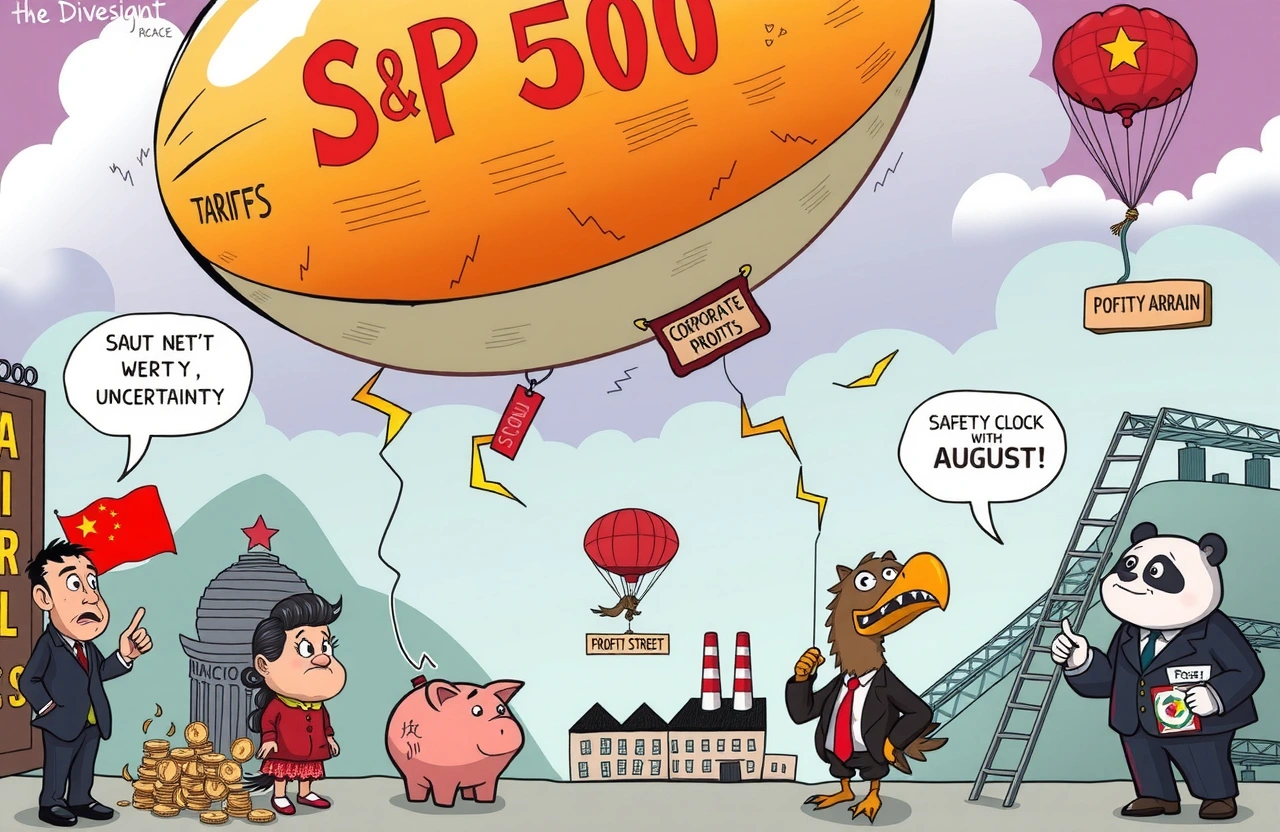The Precarious Heights of US Equities
US stocks hover near historic peaks under mounting tariff pressures, resembling what market strategist Paul Nolte evocatively termed ‘a balloon floating over Wall Street seeking a pin.’ Despite ongoing trade tensions, the S&P 500 trades at approximately 22 times forward earnings—flirting with post-pandemic valuation records—while investors appear complacent about intensifying risks. This delicate equilibrium depends critically on uninterrupted profit growth, but escalating import duties present disruptive potential comparable to a pin poised to burst the bubble.
From Corporate Earnings to Consumer Wallets
The Direct Profit Squeeze
A Bloomberg analysis reveals that average tariffs paid by US importers have surged beyond 13%, quintuple 2023 levels. HSBC global equity strategist Alastair Pinder warns: ‘This tariff escalation alone could reduce corporate earnings growth by 5%. Such compression strains margins in an environment requiring perfection.’ Companies already signalling distress include:
– General Mills projecting 1%–2% cost inflation from tariffs
– Oxford Industries (owner of Tommy Bahama) slashing profit forecasts due to $40 million tariff costs
– FedEx citing trade policies suppressing lucrative trans-Pacific air cargo revenue
Macroeconomic Domino Effect
Bloomberg Economics simulations indicate existing tariffs could shrink US GDP by 1.6% over three years while elevating consumer prices 0.9%. Federal Reserve rate-cut expectations now conflict with sticky inflation patterns embedded in June CPI data, particularly within tariff-sensitive categories including:
1. Furniture (+1.2% month-over-month)
2. Apparel (+0.8%)
3. Automotive parts (up 10.2% YoY)
Policy-Induced Market Vulnerabilities
The ‘Beautiful Act’—signed by former President Donald Trump (唐纳德·特朗普) this month—provides countervailing support through permanent corporate tax breaks projected to boost S&P 500 profits by 5%–7% according to Morgan Stanley (摩根士丹利) strategist Mike Wilson (迈克·威尔逊). Yet this stimulus contends with volatile tariff winds, as noted by Nathan Sonnenberg of Pitcairn Wealth: ‘Investors brace for policy unpredictability – what’s given via tax relief may be reclaimed through trade barriers.’
UBS strategist Bhanu Baweja crystallizes the dilemma: ‘Market indifference toward tariffs risks complacency. Once price impacts dent disposable income, stocks must acknowledge the friction.’ This echoes Treasury Secretary Janet Yellen’s (珍妮特·耶伦) recent acknowledgment of tariffs as ‘tax hikes affecting American consumers.’
The Bull-Bear Valuation Battleground
The Correction Contingency
Morgan Stanley’s Mike Wilson maintains intermediate optimism but forecasts 5%–10% near-term correction risks combined with a defensive positioning recommendation: ‘Corporate guidance alerts will precede likely Q3 turbulence.’ Echoing balloon-puncture metaphors, Murphy & Sylvest strategist Paul Nolte anticipates ‘genuine bear-market exposure’ where:
– Valuations have discounted flawless execution
– Earnings shortfalls could catalyze 20%+ downside
– Tariff escalations represent paramount tail risks
The Bull Case Anchors
Goldman Sachs (高盛集团) analysts highlight sustaining conditions including full employment, resilient margins, and declining bond yields that validate elevated multiples. Current robust consumption—visible in Capital One Financial earnings this week—further cushions impact assessments.
Tariff Transmission Mechanism
The Peterson Institute for International Economics confirms delayed economic impacts: tariff hikes require 12–15 months for full price absorption. This lag creates near-term equilibrium illusions but establishes structural vulnerability at record valuations. When tariffs rose under President Trump’s Section 201/301 actions:
– Import-intensive sectors declined 14% amid initial spikes
– Consumer staples earnings growth slowed by 300–400 basis points
– Manufacturing PMIs entered contraction territory
Current trajectories suggest analogous risks despite buoyant index levels reported in Bloomberg Finance LP datasets.
Navigating Fragile Markets
Investors face complex trade-offs between tariff-transient sectors and structural winners:
1. Cyclical industries (automakers like GM reporting this week) exhibit heightened sensitivity
2. Software/SaaS enterprises demonstrate tariff insulation
3. Domestic services firms outperform exporters
The Harvard International Finance Lab recommends optimizing geographic diversification while emphasizing quality-factor tilt (high profitability, low debt) crucial during episodic volatility.
The Inflation Feedback Loop
Persistent tariff pressures perpetuate inflationary cycles that constrain Fed easing. Higher policy rates simultaneously depress multiples while elevated input costs compress earnings—forming twin headwinds deepened whenever:
– August 1 deadlines trigger new levies
– Politicized trade rhetoric intensifies
– Supply-chain adaptations prove inadequate
The Cleveland Fed’s inflation expectation model confirms consumer anticipation of durable price spikes when tariff exposure exceeds 8%, disrupting wage-price equilibria.
Balancing Valuation Realities
The S&P 500’s parabolic ascent remains vulnerable to discontinuity triggers—whether trade reckoning, exposed corporate guidance, or monetary pivots. Yet epochal markets function paradoxically: danger exists but opportunities endure where fundamentals exceed pricing thresholds. Monitor earnings revisions structurally; position tactically via:
– Defensive hedges using VIX derivatives
– Earnings-momentum screening
– Dollar-cost averaging during corrections
Recall that after every prior ‘balloon pop’ event—whether dot-com bust or global financial crisis—markets eventually rebuilt loftier heights.




